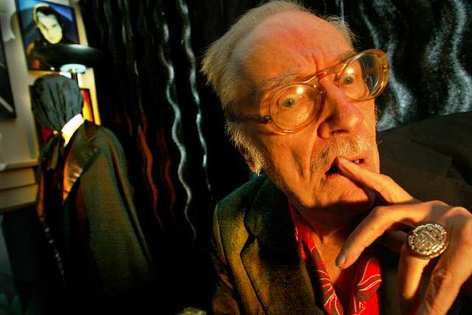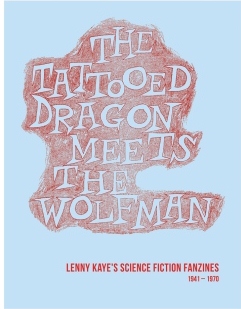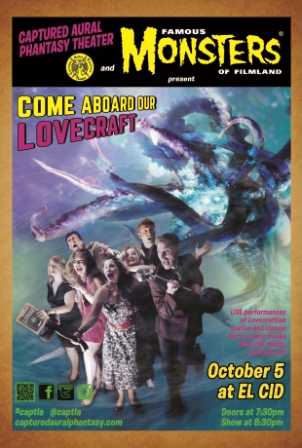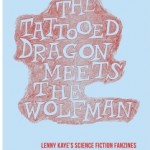Here are 16 developments of interest to fans.
(1) We’ve all heard about parents who hope their child inherits the smart one’s brains and the good-looking one’s beauty. Tell the truth, didn’t you ask yourself what if, instead, the child inherits all the traits they don’t like?
That analogy came to mind when I read what happened to the Hollywood filmmakers who are D&D fans and tried to make a documentary about the history of their favorite game.
The New York Times story begins:
For a certain sort of fan, the crowdfunding pitch was impossible to resist. Here was a chance, it announced, to support a documentary about the immortal saga of the legendary game that all but revolutionized modern life. No pressure.
Three filmmakers promised nothing less than the origin story of the fantasy role-playing game Dungeons & Dragons, “a cautionary tale of an empire built by friends and lost through betrayal, enmity, poor management, hubris and litigation,” they wrote on their Kickstarter page in 2012. They planned to chronicle the bitter battle waged by Gary Gygax and Dave Arneson, the game’s creators, over credit and royalties.
In other words, they wrote: “Imagine ‘The Social Network’ ” — the box office hit about the tortuous story of Facebook’s founding — “but no one ends up rich.”
If the filmmakers saw a cautionary tale in the story of their shared passion, they failed to heed its lessons. More than $250,000 in Kickstarter pledges and two years later, there is no documentary, only broken friendships and a lawsuit.
(2) Scott Edelman’s review of Ray Bradbury Unbound by Jonathan R. Eller for the Washington Post doesn’t start with a narrative hook – it starts with a narrative harpoon.
For most of us, if a Great White Whale entered our life and changed it forever, the experience would be metaphorical.
Not so for Ray Bradbury.
The review dwells on the provocative question raised in Eller’s biography about the roads not taken because Bradbury devoted so much of his talent to Hollywood scriptwriting.
(3) The “New Weird” is a thing, one that fans find easiest to define by saying what it’s not:
The New Weird often refuses to domesticate the experience of wonder or horror, refuses to make the ‘strange’ in the story unstrange. In traditional science fiction, fantasy, and horror, the reader encounters wonders (or horrors) that are later subjugated under an order of knowledge or a new set of rules the reader learns. The food that the fairies offer you may be strange and surprising, but eventually you learn where it comes from or at least whether or not you’re expected to eat it. The Enterprise‘s ability to beam you down to a planet is at first a wondrous shock, but quickly you learn that it is explainable as an advanced technology that has behind it an entire economy, political system, all so carefully and consistently defined that publishers have released encyclopedias, starship technical manuals, Klingon language textbooks, and monographs on the physics of the Star Trek universe. So the wonder is swiftly and thoroughly tamed.
And then presumably, having learned the rules of the fantasy world and having grappled with the wonders in that world, the reader emerges from the story somewhat wiser and maybe has insight (emotional, intellectual, or otherwise) into the rules of the reader’s own world. That’s a sort of underlying assumption in much speculative fiction.
In the New Weird, what frequently happens is that the new rules aren’t laid out, or if they are, they are quickly rendered suspect. The world the reader has entered remains strange to one degree or another, and in some of the most compelling fiction, the reader is invited to become estranged from his or her own perceptions, too.
(4) Toronto is another good place to become estranged from one’s own perceptions. Either that or public transportation in James Davis Nicoll’s town makes a regular stop somewhere in urban fantasy:
I also got to watch a squirrel follow someone onto a bus, stand on hind legs looking at the passengers and then leave. My guess is it did not have exact change for the fare. The driver did not seem fazed, which makes me wonder if this has happened before.
(5) A few technical glitches during Loncon 3’s awards ceremonies went almost unnoticed thanks to the hosts’ quick wit. But not entirely unnoticed. John Coker III spilled the beans in Scientifiction #41, the newsletter of First Fandom.
Steve Francis’ microphone was not working at the beginning of the presentation of the First Fandom Awards. Mary Robinette Kowal stepped up to him and said, “Speak into my bosom” (lapel microphone). At the 2014 Hugo ceremony, Bryan Talbot’s microphone wasn’t working and co-host Geoff Ryman stepped forward and said, “Here, just speak into my chest.”
(6) Andy Greenwald, Grantland’s genius TV reviewer, celebrated the 10th anniversary of his favorite show’s final episode in ”The Lessons of ‘Lost”: Understanding the Most Important Network Show of the Past 10 Years”.
But if Lost taught me anything, it’s that time travel isn’t just possible, it’s downright necessary. Only by truly examining where we’ve been can we make the adjustments to get us where we need to be. Ten years removed from the pilot, it’s clear that the television industry learned all the wrong lessons from Lost’s success. (Among them: Josh Holloway can be a leading man.) With that in mind, here’s my list of six essential things that Lost could still teach the broadcast networks. Don’t fight it. It’s time to go back.
1. Characters First, Concept Second
This would seem like a no-brainer, but then you remember FlashForward. That high-concept, low-IQ failure from 2009 was only one of a whole flock of series green-lit in Lost’s wake, nearly all of which fundamentally misunderstood the show’s appeal. It was never about the island; it was always about the people. Yet again and again the networks tried to reverse-engineer a hit by coming up with some ludicrously unsustainable conceit — in FlashForward it involved a mass hallucination of a day six months in the future; IRL the show was canceled before even getting there — and then attempting to fill it with compelling characters. As if an audience could ever care about the fate of a world populated solely by cardboard cutouts.
(7) Heritage Auctions blogger Brian Shipman was captivated by J.J. Abrams’ 2013 book S. He believes there’s a pirate treasure awaiting the reader who solves the mystery.
Once LOST ended, I longed for another experience that combined great story, mysterious events, and puzzles woven directly into the story. I didn’t think it would happen. But then, I stumbled onto a book called “S.” And when I saw that J.J. Abrams conceived it, the “same guy” that did LOST – I enthusiastically began the quest.
It’s hard to call “S” a book. “S” is more of an experience that comes in a box with many, many parts. It is inherently a collector’s item. And within it are multiple, stand-alone collector’s items. When you break the seal of the box that contains “S.”, out slides what initially appears to be a single book. An old book, Ship of Theseus,written in 1949 by the fictitious author V.M. Straka. The book appears to be stolen from a high school library in California by a young student named Eric who pencils in his notes over time. Years later, when a college student named Jen picks up the book in the university library and sees his notes, she inks a response. Before long, the two begin a relationship in the margins, discussing the mysterious book itself and the connection that flourishes between them.
People who obsess about the book have already created a webpage listing all the inserts.
(8) Wired’s oral history of Mystery Science Theatre 3000 from a few months ago still may be news to you.
Hodgson set the show in outer space and cast himself as “Joel,” a likable janitor who is blasted into orbit and forced to endure all manner of bad movies. Inspired by the 1972 sci-fi drama Silent Running—in which Bruce Dern plays an outer-space botanist who befriends a trio of robots—Joel created and built three chatty pals to join him: the pseudo-suave, sarcastic Tom Servo; the bigmouthed, perpetually eye-rolling Crow T. Robot; and the sweet (but appropriately spacey) sidekick Gypsy. Though Jim Mallon would eventually play Gypsy, in the early seasons the robots would be voiced by local comedians (and MST3K costars) Josh Weinstein and Trace Beaulieu. The program debuted on KTMA on Thanksgiving Day 1988.
Weinstein: I was inspired to make Tom Servo sort of a smarmy AM radio DJ. He had this incredibly inflated opinion of himself and considered himself a ladies’ robot.
Hodgson: Josh really is Tom Servo. When Josh was 16, he drank single-malt scotch and smoked cigars; he was like a 40-year-old man in a 17-year-old body, which is like Tom Servo. And Crow is like Trace: He can do millions of characters, and he splits the difference between being playful and cynical.
Mallon: If I channeled anybody for Gypsy, I channeled my mom. She had a heart of gold and always looked to the best of everything and the best of everyone. And when confronted with difficult things, she was somewhat lost [Laughs]. She didn’t know how to negotiate when things went poorly. She would be hurt, so Gypsy would be hurt at times and turn to the other robots for support.
(9) Quidditch players want to be taken seriously as athletes. Which they think requires transforming themselves into mundanes, as Washington Post reporter Jessica Contrera learned while attending the third annual conference of the International Quidditch Association –
In recent years and in conferences such as the Washington gathering, the players have been actively disassociating themselves from the fantasy world in which their sport was born.
Though most still love the series, they have decided that the sport has outgrown its children’s-novel roots.
(10) Or are they’re simply meeting the real world halfway? It seems invisibility cloaks aren’t just for the kids at Hogwart’s anymore.
‘The Rochester Cloak’, as it’s being dubbed, uses a simplified four-lens system that essentially bends light around any objects you put into the middle of the chain – you’re able to see the area in the background as normal, but not the item in the foreground. According to its inventors, it can be scaled up using any size of lens, and the team responsible for the setup has used standard, off-the-shelf hardware.
(11) One of Harlan Ellison’s famous short stories was inspired by his disgust that dozens of witnesses did nothing as a New York woman was being murdered. However, Kevin Cook’s recent book, Kitty Genovese: The Murder, The Bystanders, The Crime that Changed America, challenges what was reported in the news, and what everyone thinks they know about that night.
One of the stories about which we spoke was The Whimper of Whipped Dogs, which won the Edgar Allan Poe prize for best short story in 1974, and which documents the brutal attack on a young woman in the courtyard of a New York apartment block, whose residents silently watch from their windows as she is stabbed to death. The story attempted to characterise evil as a numinous force drifting up from the killer and swirling around each of the witnesses who did nothing to halt his hand….
The problem for sociologists is that it didn’t actually happen as it was originally reported… [Instead] of 38 witnesses, there was 49. However. all but two of them reported seeing nothing and hearing only indistinct noises which they only associated with the crime afterwards. The idea of a community of the damned leering out the window to watch, an image perpetuated for the past 50 years, is utterly false.
(12) The following item isn’t sf. (Someone is sure to point that out). I was impressed by baseball executive Tony LaRussa’s cogent dissertation about fear, given during his commencement address at Washington University in St. Louis. I didn’t want you to miss it.
And I’m going to tell you that I’m anxious about these remarks, to the point I’m fearful. I’ve actually learned the difference between good fear and bad fear. I talked this morning, I was really struck by the Olympic music, I talked this morning with an Olympian, distinguished Olympic swimmer, and I told her what I was doing, and she said she’d been invited before and was always too afraid to accept the invitation. And I thought, respectfully, I would talk to her about good fear/bad fear because that’s bad fear. You feel this anxiety, the expectation of pressure, and you decide that you’re going to dodge it. And you’re just not going to participate. You will regret that the rest of your life, and you’re going to face a lot of opportunities where there’s an uncertain outcome and you’ve been given the opportunity to try it. Bad fear means you call in sick. And you will never ever have a strong personal feeling and a strong enough ego to be successful and take advantage of what you’ve gone through your whole life, including your education at Washington University.
The good fear is one that you recognize, to have this anxiety is normal. So I’m nervous. And what that has caused me to do is every day for the last month, I’ve thought about this few minutes that I’m going to speak to you, and I was up at 5:30 this morning changing it. But my point is, I’m not afraid to try to say some things this morning that hopefully will be helpful. I’m more afraid of saying no, and not trying it, and I suggest to you that that’s an important lesson going forward. Don’t be afraid. Good fear makes you study for a test because you want to make sure to do your best. Bad fear makes you afraid to take the test.
(13) Loved USA Today’s headline (from the web edition) – “Are you on the list? ‘Genius grant’ winners named.”
Yessir, I thought I’d better click that link immediately. And can you believe it? They left me off again.
MacArthur today named its 2014 class of MacArthur Fellows, recognizing 21 exceptionally creative individuals with a track record of achievement and the potential for significant contributions in the future….
In her comic strip, “Dykes to Watch Out For,” which ran from 1983 to 2008, [Alison Bechdel] offered a basic metric used to illustrate just how male-dominated the film industry actually is.
The test, which Bechdel coined in 1985 in a strip titled “The Rule,” consists of three questions which set a baseline not for gender parity, but for the simple inclusion of women in a film in any meaningful way:
1) Does it have two female characters?
2) Who talk to each other?
3) About something other than a man?
If the answer to all three questions is yes, the film passes the Bechdel test.
(14) Until it was pointed out to me, I never noticed one particular fake brand of cigarettes is commonly used in Hollywood productions — Morley. John King Tarpinian noticed in The Strain that a character’s mother smokes Morley cigarettes, and made the connection that the same brand was smoked by the Smoking Man in The X-Files.
The Strain is the brainchild of Guillermo del Toro who pays attention to such details, causing John to wonder if Guillermo was paying homage.
Everyone say the obvious tagline along with me – “The truth is out there!”
(15) Fans interested in a pulls-no-punches account of Robert Bloch’s pro work will find it in Benjamin Welton’s article for Ravenous Monsters, “Straitjackets and Sleepwalkers: Robert Bloch in the Movies Part One” —
In 1962, Bloch finally got the chance to write for a Hollywood film. His first screenplay was for Owen Crump’s little-known thriller The Couch. Bloch’s next screenplay seemed, at first, like the very project that was going to put his career in full motion forward. Directed by Roger Kay, The Cabinet of Dr. Caligari proved to be a thoroughgoing debacle. First of all, despite the title, Kay’s The Cabinet of Dr. Caligari has almost nothing to do with Robert Wiene’s German Expressionist classic. Second of all, Kay’s abuse of Bloch was legendary, and Bloch’s autobiography, Once Around the Bloch, devotes pages upon pages to Kay’s attempts to rob Bloch of the writing credit he deserved. Ultimately, the 1962 version of The Cabinet of Dr. Caligari proved to be a monumental flub.
(Part Two was not yet posted when I checked.)
(16) Wherever Robert Bloch is right now, he can be glad that movie came out before Grantland’s film reviewer was born. You may have noticed I’ve had writers mad at me before. But the writer I really don’t want mad at me is Wesley Morris, who delivers putdowns like —
Jonathan Tropper adapted his own novel, which, in this case, is as ill-advised as performing one’s own autopsy.
[Thanks for these links goes out to John King Tarpinian, Martin Morse Wooster, David Klaus, Chronicles of the Dawn Patrol and Andrew Porter.]
Update 09/30/2014: Corrected the count of “developments.” Morris Keesan and his eagle eye saved me again.
 (1) Forry Ackerman’s hand went unsold in the Bradbury auction. Well, not his actual hand, a sculpture of it. Presumably nobody realized that’s what it is or there might have been takers.
(1) Forry Ackerman’s hand went unsold in the Bradbury auction. Well, not his actual hand, a sculpture of it. Presumably nobody realized that’s what it is or there might have been takers.



